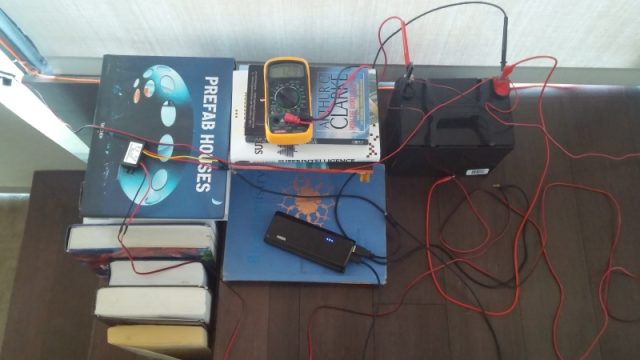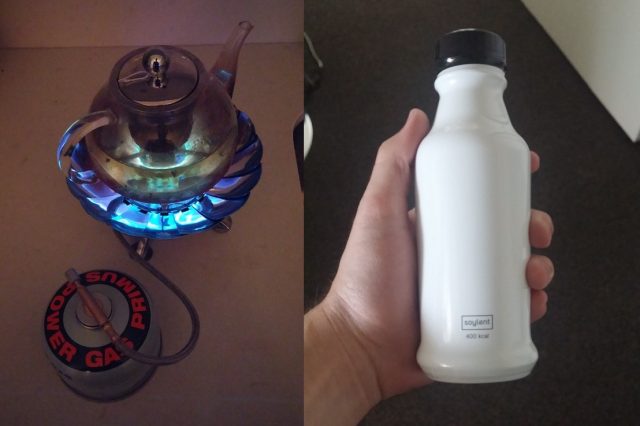
The walls are buzzing. I know this because I have a magnet implanted in my hand and whenever I reach near an outlet I can feel them. I can feel fortresses of industry miles away burning prehistoric hydrocarbons by the megaton. I can feel the searing pain and loss of consciousness from when I was shocked by exposed house wiring as a boy. I can feel the deep cut of the power bill when I was living near the poverty line. I can feel the cold uncertainty of the first time the power went out due to a storm when I was a child. How long before the delicate veil of civilization turns to savagery with no light nor heat nor refrigeration?
The grid, smart or not, is wasteful. Power generation produces 32% of all greenhouse gases, more than any other economic sector. Most power in the US is generated by burning coal, immediately squandering 67% of its energy, then run through a steam turbine, losing another 50%, then sent across transmission lines, losing another 5%, then to charge a DC device like a cell phone another 50% is lost in conversion. This means for 100 watts of coal or oil burned my phone gets a mere 16. In this light a solar panel that is 18% efficient doesn’t seem that bad.
Instead of ever increasing our energy production, what if we focused instead on reducing our consumption? I expect power will be at a premium in our first space colonies, and DC only from solar cells. So, I embarked on an experiment to see if I could survive without the luxury of alternating current.
Powerplants
In 2013 United States utilities generated 4,066 TWh of electricity and collected $370 billion in revenue. Of this, 70% came from fossil fuel sources like coal and natural gas. Nuclear has a strong showing of 20% and “renewables” are the other 10%, the majority of which is hydroelectric. In fact, the 5 largest power plants in the world are all hydroelectric. Three Gorges Dam alone generates 22,500MW, 10x the capacity of a typical US coal plant. In the US the highest consuming segment is residential, over commercial and industrial, with average use of 909 KWh per month per customer at a cost of $110.
My home city of Los Angeles has peak power demand of 6,125MW. Most of it is imported from coal plants in Utah, Arizona, and Nevada. The city generates about 25% of its own power from 4 local natural gas facilities, and another 11% comes from Diablo Canyon Nuclear Power Plant, whose twin reactors generate 2,242MW with 193 fuel assemblies. Each assembly contains around 200 fuel rods and each fuel rod contains roughly 14 million half-inch Uranium pellets, which are 3.5-5% Uranium-235. That is about 75 tons of Uranium, which must be changed out every 2 years. Still, I prefer it to coal.

Maintaining these facilities takes thousands of workers and outages are still common. Los Angeles uses overhead power lines that are unsightly and vulnerable to auto accidents. In 2005 a DWP worker accidentally cut a line that severed power to half of Los Angeles. In 2013 Diablo Canyon was forced to shut down due to an influx of jellyfish. Diablo Canyon is also built less than a mile from a major fault line. The largest photovoltaic power plant in the world, Topaz Solar Farm cost $2.5 billion and while its “nameplate capacity” is 550MW, due to solar’s low capacity factor really generates a paltry average of 125MW.
Now I don’t need any of them. I am electrically self-reliant. My home life runs comfortably on a single 100W solar panel, which cost $150 and was available on Amazon Prime. I tracked down a few manufacturers in China who all said it costs around $40 to make. The US for some reason leverages massive tariffs on Chinese solar panels, so they ship them through Malaysian customs. Why do the politicians even bother?
For storage a $65 lead acid automobile battery does the trick. It’s 12V so can be charged directly from the solar panel, and holds 420Wh, way more than I use in a day. That’s $0.15 / Wh so I don’t see why everyone is so excited about Tesla charging $0.43 / Wh for the Powerwall, sans inverter and installation.
My New Power Source

I have been living on this system for a few months now and am thrilled how well it works. Every morning I arise and marvel at the free, reliable energy generated in a cosmic fusion reactor and beamed to my apartment through space. Of course, solar would have been prohibitively expensive and complicated had I not reduced my consumption to a fraction of what the average home uses. Here is how I did it.
Kitchen
Kitchens are expensive and dirty. This home manufacturing center has been by far the most liberating to eliminate. They are the greediest consumers of power, water, and labor and produce the most noise and garbage of any room. Moreover, they can be made totally unnecessary with a few practical life hacks.
First, I never cook. I am all for self-reliance but repeating the same labor over and over for the sake of existence is the realm of robots. I utilize soylent only at home and go out to eat when craving company or flavor. This eliminates a panoply of expensive tools and rotting ingredients I would need to spend an unconscionable amount of time sourcing, preparing, and cleaning. It also gives me an incentive to explore the city’s fine restaurants and ask friends out to eat. In fact, I find soylent has made me more social when it comes to food. I can spend the money I saved from groceries and take out to buy a friend lunch or dinner. When soylent 2.0 reached private beta, I was thrilled to learn that thanks to aseptic processing the product does not require refrigeration, and will still keep its nutrition for at least a year. It tastes better cold but I think it’s fine warm. Getting rid of my fridge was one of the greatest days of my life. Nevermore will I listen to that damn compressor moan.
I have not set foot in a grocery store in years. Nevermore will I bumble through endless confusing aisles like a pack-donkey searching for feed while the smell of rotting flesh fills my nostrils and fluorescent lights sear my eyeballs and sappy love songs torture my ears. Grocery shopping is a multisensory living nightmare. There are services that will make someone else do it for me but I cannot in good conscience force a fellow soul through this gauntlet.
I buy my staple food online like a civilized person. It takes me mere seconds to order enough soylent for a month, and version 2.0 does not require any preparation, so I got rid of my noisy blender. At less than $2.50 / meal it also saves me loads of cash, and I appreciate the use of more soy and less rice, finally bringing a nutritionally optimal PDCAAS score of 1.0 while improving the taste and especially texture. I also think it’s crazy cool that some of the ingredients are made by algae rather than water-guzzling pesticide-spraying farms.

Next, I switched from beer to red wine. I buy with Saucey so I don’t have to use awful retail stores. Decent red wine is surprisingly cheap, pleasurable, and does not require refrigeration. I also end up drinking less liquid overall, meaning fewer bottles to throw away (I average about one trashbag / month) and fewer trips to the bathroom, meaning for a comparable amount of alcohol, when wine is consumed instead of beer there is less electrolyte loss and less after effects.
For coffee and tea I use a butane stove. It is much cheaper and more energy-efficient than a Keurig, which can use $160 of electricity / year. It doesn’t waste endless non-recyclable “K-Cups” and I find heats water about as fast. Also fire is much more beautiful than blinking LEDs.
With no fridge, no dishes, no microwave, no oven, no range, no dishwasher, no utensils, no pests, no cleaning products nor dirty rags, my life is considerably simpler, lighter and cleaner than before. I think it was a bit presumptuous for the architect to assume I wanted a kitchen with my apartment and make me pay for it. My home is a place of peace. I don’t want to live with red-hot heating elements and razor-sharp knives. That sounds like a torture chamber. However, it’s not a total loss. I was able to use the cabinets to store part of my book collection.
reader comments
736